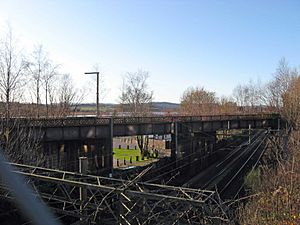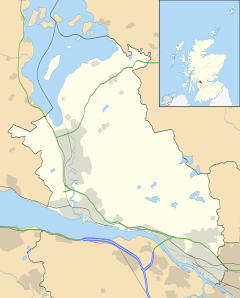Bowling, West Dunbartonshire facts for kids
Quick facts for kids Bowling
|
|
|---|---|
 Bowling Harbour in 2008 |
|
| Population | 560 (2020) |
| OS grid reference | NS445737 |
| Civil parish |
|
| Council area | |
| Lieutenancy area | |
| Country | Scotland |
| Sovereign state | United Kingdom |
| Post town | GLASGOW |
| Postcode district | G60 |
| Dialling code | 01389 |
| Police | Strathclyde |
| Fire | Strathclyde |
| Ambulance | Scottish |
| EU Parliament | Scotland |
| UK Parliament | |
| Scottish Parliament | |
Bowling (Scots: Bowlin, Scottish Gaelic: Bolan) is a village in West Dunbartonshire, Scotland. In 2015, about 740 people lived there.
The village is located on the north bank of the Firth of Clyde. It sits between the towns of Clydebank and Dumbarton. Bowling is about 1.5 miles (2.4 km) west of Old Kilpatrick. Old Kilpatrick marks one end of the Antonine Wall. This wall was the very edge of the Roman Empire on the west coast of Great Britain.
Contents
The Forth and Clyde Canal
Bowling is where the Forth and Clyde Canal begins on its western side. This important canal opened in 1790. It is known as the western entrance to Scotland's Lowland canals.
In 2008, British Waterways Scotland and Scottish Enterprise Dunbartonshire worked together. They spent £1.4 million to improve Bowling Basin. This project added more places for boats to dock. It also provided better facilities for canal users. There were also plans to use a large area of land (about 140 acres or 57 hectares) next to Bowling. This was to be done with Clydeport.
In June 2008, local leader Denis Agnew joined schoolchildren and community groups. They celebrated a £163,000 project. This project improved seven kilometers of towpath. The path runs along the Forth & Clyde Canal from Bowling Harbour to Whitecrook in Clydebank.
In 2007, Bowling welcomed the "Vital Spark". This was one of only five "Clyde puffers" still existing. It was the first puffer to sail into Bowling Harbour in over 40 years. The Forth & Clyde Canal is seen as the birthplace of these puffers. They had to be small enough to fit through the Crinan Canal. The famous Vital Spark appeared in the "Para Handy" books by Neil Munro. It was also featured in two TV shows with the same name.
Shipbuilding in Bowling
Bowling has a long history of building and repairing ships. When the Forth and Clyde Canal opened in Bowling in 1790, more ships started passing through the village on their way to Glasgow.
The first shipbuilder in Bowling was Thomas McGill from Glasgow. He rented the Graving dock in 1800. McGill and his two sons built ships in Bowling until 1843. Their shipyard had to close because the Forth and Clyde Canal basin was being made bigger.
In 1834, George Mills and Charles Wood started a shipyard together. It was located at Littlemill in Bowling. This partnership did not last long. Charles Wood left to start his own shipyard in Dumbarton. In 1840 or 1841, George Mills stopped building ships, and the shipyard closed.
In 1851, a new company was formed in Bowling. Thomas McGill's two sons, David and Thomas, joined with James Scott. James Scott's father owned land at Littlemill. The company was called Scott & MacGill. This small shipyard built wooden sailing ships. Then, in 1874, they built their first ship made of iron.
In 1876, Thomas McGill retired from the company. James Scott was left to run it alone. The company's name changed to Scott and Company. In 1892, James Scott formed a partnership with his two sons, Charles Wood Scott and James Scott Junior. The company's name changed again, to Scott and Sons.
The company continued to do well into the 20th century. They built more than 450 ships. Many of these were passenger ships and coasters for Gardner & Stewart. In 1958, James W. Scott retired. The company then became a limited company, called Scott Sons (Bowling) Limited.
In June 1965, Scotts Shipbuilding and Engineering Company of Greenock took over the company. In 1979, the decision was made to close the shipbuilding yard. The last ship to leave the yard was the Laggan. It was built for Forth Tugs Limited of Grangemouth.
The MV Panagiotis Shipwreck
One well-known ship built by Scott was the MV Saint Bedan. It was launched in January 1937. After being owned by different companies and changing its name several times, it became the MV Panagiotis. It is said to have been used for smuggling in the Ionian Sea. In 1980, it ran aground at Navagio Beach. This beach is on the Ionian Island of Zakynthos (Zante). Today, it is one of the most famous and beautiful shipwrecks in the world.
Fuel Oil Terminal
The site of the former ExxonMobil fuel oil terminal is now planned for new developments. These plans include different types of buildings and uses for the land.
Famous People from Bowling
Many notable people have lived in Bowling, including:
- William Burrell, a famous art collector
- George Mills, a shipbuilder
- Talwin Morris, a leader in the Glasgow Style art movement
- George Murdoch, a former Lord Provost (mayor) of Glasgow
- John Murray, who worked to end slavery
- Annette Pearse, a gallery director
Glenarbuck House
Glenarbuck House is a historic building in Bowling. It is listed as a Category B building. It was built in 1804 for a merchant named Gilbert Hamilton. He was important in Glasgow, being the first president of the Glasgow Humane Society and a founder of the Glasgow Chamber of Commerce. He was also Glasgow's Lord Provost in 1792. Later, the Duke of Sutherland and the Scott family (the shipbuilders) owned the house.
Rail Transport

Bowling railway station first opened in 1850. At that time, the North Clyde line went through Dumbarton to Balloch. In 1858, the line was extended. It then went to Glasgow in the east and Helensburgh in the west.
Between 1896 and 1951, Bowling also had a second station. This station was on the Caledonian Railway's Lanarkshire and Dunbartonshire Railway line. Its old track is now a path for walking and cycling through the village.
Today, ScotRail trains stop at Bowling. There are two trains per hour in each direction.
Bowling Today
Bowling is part of the same church parish as Old Kilpatrick Church. The old church building in Bowling has been changed into homes.
The village holds an annual Gala Day in June. During this event, a girl is crowned Queen for the day. The ceremony starts at Bowling Memorial Park and continues to Bowling Hall.
Images for kids
See also
 In Spanish: Bowling (West Dunbartonshire) para niños
In Spanish: Bowling (West Dunbartonshire) para niños






